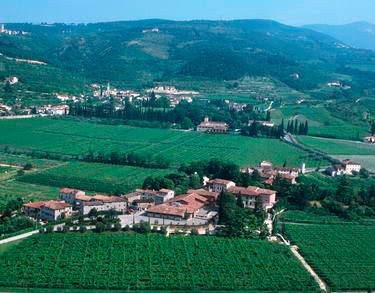Hailing from Italy's Veneto wine region and owned by the Boscaini family for six generations, the primary aim of Masi Agricola is to emphasize the personality of their wines while maintaining a distinct Venetian style. In addition to preserving the traditional style, Masi also maintains a focus on technological advancement and continuously seeks to integrate the two.
In 1958, Masi was in the forefront of the work to identify the historic "cru" vineyard sites for Amarone, the rich, Italian dry red wine made from the partially dried grapes of the Corvina, Rondinella and Molinara varieties. Masi even updated Amarone's style using new appassimento and vinification technologies. Appassimento is the traditional method used in the Venetian regions to give wines greater concentrations of aromas and flavours. The grapes are laid out to rest for a long time on bamboo racks before vinification. Implementing their modernized version of the process, Masi produces five Amarone wines and three Reciotos, made with "100% semi-dried grapes" which gives character to a series of "double fermentation" wines, of which their wine Campofiorin is the archetype. As far as white wines, the Masi Masianco, a white wine made from pinot grigio and verduzzo grape varieties, is an example of the technique of "blending wine made from fresh grapes with wine made from semi-dried grapes." Masi has also taken its expertise in appassimento out of its origins in Italy to Argentina, with Corbec and Passo Doble.
In addition to its experimentation with principal grape varieties, Masi is also a pioneer in the experimentation and use of secondary Veronese grape varieties such as Oseleta, Dindarella, Croatina, Negrara and Forsellina. Over the years, Masi has earned the distinct recognition of having "revolutionized the art of wine-making in the Venetian region," and garnering the praise of revered British author and wine expert, Hugh Johnson, who defines Masi as "a touchstone for Veronese wines."
In 1958, Masi was in the forefront of the work to identify the historic "cru" vineyard sites for Amarone, the rich, Italian dry red wine made from the partially dried grapes of the Corvina, Rondinella and Molinara varieties. Masi even updated Amarone's style using new appassimento and vinification technologies. Appassimento is the traditional method used in the Venetian regions to give wines greater concentrations of aromas and flavours. The grapes are laid out to rest for a long time on bamboo racks before vinification. Implementing their modernized version of the process, Masi produces five Amarone wines and three Reciotos, made with "100% semi-dried grapes" which gives character to a series of "double fermentation" wines, of which their wine Campofiorin is the archetype. As far as white wines, the Masi Masianco, a white wine made from pinot grigio and verduzzo grape varieties, is an example of the technique of "blending wine made from fresh grapes with wine made from semi-dried grapes." Masi has also taken its expertise in appassimento out of its origins in Italy to Argentina, with Corbec and Passo Doble.
In addition to its experimentation with principal grape varieties, Masi is also a pioneer in the experimentation and use of secondary Veronese grape varieties such as Oseleta, Dindarella, Croatina, Negrara and Forsellina. Over the years, Masi has earned the distinct recognition of having "revolutionized the art of wine-making in the Venetian region," and garnering the praise of revered British author and wine expert, Hugh Johnson, who defines Masi as "a touchstone for Veronese wines."
 |
| Tony Apostolakos |
Cheers,















No comments:
Post a Comment